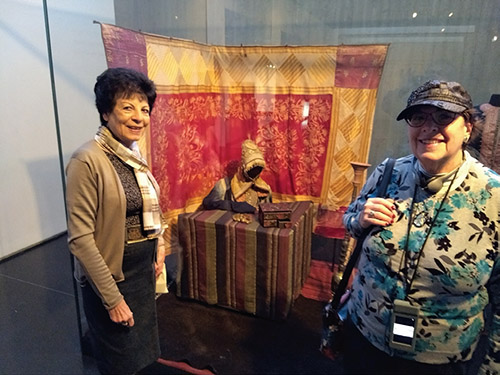

During our yearly trips to Israel, we are always looking to identify the latest sites and the newest offerings. The Israel Museum in Jerusalem, now in its 54th year, is often overlooked, with a “been there, done that” attitude. Not this time! We spent a most incredible 3 1/2 hours exploring three new history-making exhibits at the Israel Museum with our charming, passionate and well-informed guide, Chaya Cohen, who has been serving as a docent at the museum for over 20 years.
After taking us through the classic Jewish Ceremonial Life area, which has recently been attractively revamped, and highlighting details we had overlooked before, our guide led us to the entrance of the brand new and historic exhibit “Maimonides: A Legacy in Script.” The exhibit, which opened in December and runs through the end of April, is the culmination of a two-part collaborative project of the Israel Museum and the National Library of Israel. The exhibit at the museum sheds light on this super-scholar’s impact, which changed Jewish practice for all time through his contributions to the religious, philosophical and ethical principles of Jewish life since the 12th century. The exhibit elucidates Maimonides’ multifaceted persona, offering a deeper understanding of his legacy through illuminated manuscripts of his revolutionary Mishneh Torah, which standardized and codified Jewish law and made it accessible to all levels of intellectual understanding. The highlight of the exhibit is the authorized proofread version of the Mishneh Torah bearing Maimonides’ signature and containing the inscription written in his own hand: “It has been corrected from my own book,” on loan from the Bodleian Libraries of Oxford University.
Also on display are original copies of Maimonides’ philosophical treatises, among them the universally studied Guide to the Perplexed, which highlights the connections among science, general studies and Torah. Eight audio-visual stations guide the visitor, including the younger set, through Maimonides’ life journeys, and the challenges he was forced to endure from those opposing his compendiums. Earphones offer narration in Hebrew, English and Arabic.
From the sublime heights of the intellect, we proceeded to the realm of the earthly as we entered the halls of the “Fashion Statements: Decoding Israeli Dress” exhibit. The exhibit, which runs until the first week of April, surveys a century of dress in Israel, from the late 19th century native pre-Zionist fashion, through the intervening influences of Europe and Asia, to the current creativity of today’s Israeli fashion. Tastefully exhibited on runways, backed by films, photography and sound effects, the exhibit offers a kaleidoscope of sumptuous fashions that re-create the history of Israel for us.
The exhibit’s 150 items begin with desert garb and continue with the Yemenite-influenced embroidery of Maskit and then on to garments inspired by religious themes such as the black-and-white weave of the tallit and the Magen David cutouts in the black evening jacket. The red-and-white weave of the keffiyeh is woven by a trio of designers, Palestinian, Russian and Israeli, into three contemporary dresses and capes. The early years of the country are reflected in the khaki work shorts and kova tembel, fool’s hat, worn by the early pioneers. Moving into the 1940s and 1950s, when Israel perceived itself as the Paris of the Middle East, rotating mannequins display sequined silks and satins, the equal of those from Parisian salons. In the 1960s and 1970s Israeli fashion was in the limelight with its Beged-Or leather creations and its widely popular and expensive Gottex bathing attire. After the slump of the 1980s, Israel regained ground in the fashion industry when graduates from its schools of design emerged on the fashion scene. The recent fashions are more than clothing, but rather works of art created to make statements about contemporary life.
A third exhibit not to be missed is in the Archeology Wing and will be available for viewing until the beginning of March. Titled “Freud of the Rings,” it consists of six rings discovered from around the world that Sigmund Freud, the father of psychoanalysis, gave as gifts to his inner circle of pupils. Each ring is personalized with ancient gems engraved with images from Roman mythology to represent that particular student’s interests and research. This is the first time that the rings, including the one belonging to Freud himself, have been displayed side by side. In addition to the rings, the exhibit displays antiquities from Freud’s own collection that relate to his personal life and his psychoanalytic theories.
The museum is a gem, offering over 500,000 objects of art and archeology. In addition, it houses the Shrine of the Book, the Billy Rose Art Garden and a dynamic Youth Wing on its 20-acre campus.
By Pearl Markovitz










